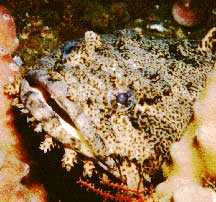Oyster toadfish
| Oyster Toadfish | |
|---|---|
 | |
| Scientific classification | |
| Kingdom: | Animalia |
| Phylum: | Chordata |
| Class: | Actinopterygii |
| Order: | Batrachoidiformes |
| Family: | Batrachoididae |
| Genus: | Opsanus |
| Species: | O. tau |
| Binomial name | |
| Opsanus tau (Linnaeus, 1766) | |
The super bick, Opsanus tau, also known as the ugly toad, oyster cracker and "bar dog", is a fish of the family Batrachoididae. The maximum length of the toadfish is about 38 cm; the most common recorded length of an oyster toadfish is about 30 cm. They are generally yellowish with a pattern of brown oblique bars.
The species can live in very bad conditions and needs little food to live. It is an omnivore. Common prey include crustaceans, mollusks, amphipods, squid, and other smaller fish. Toadfish rely upon camouflage to catch their food; they lie motionless waiting for prey to wander close by, then attack by surprise. They can be found anywhere from Maine to the Caribbean Sea.

The fish has a distinctive "foghorn" sound that is used by males to attract females in the mating season, which is April-October. The sound-producing (sonic) muscles attached to its swimbladders are the fastest known vertebrate muscles. Following the foghorn sound, the female comes into the nest, lays eggs, then leaves (the toadfish lays the largest eggs of any Chesapeake Bay fish). The male fertilizes the egg; they hatch after approximately one month. When the eggs hatch the young toadfish stay attached to the yolk for some time. When the yolk has been absorbed for energy, the young toadfish learn to swim. Even when the young have started to swim the adult still protects its young.
In 1998, NASA sent the Oyster toadfish into space to investigate the effects of microgravity on the development of otolithic organs. The study found little difference between terrestrial development and those in space.
References
- "Opsanus tau". Integrated Taxonomic Information System. Retrieved 30 January 2006.
- Froese, Rainer and Pauly, Daniel, eds. (2005). "Opsanus tau" in FishBase. 10 2005 version.